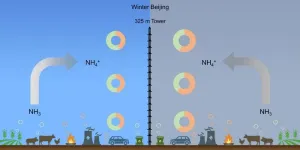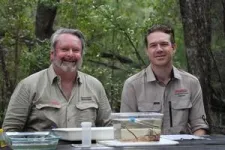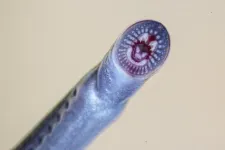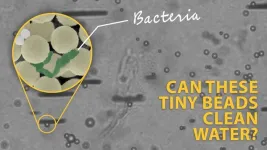(Press-News.org) Recently, Science Bulletin published a research conducted by Prof. Pingqing Fu and Dr. Libin Wu from Tianjin University, Peng Wang from Fudan University, and their Chinese and foreign collaborators. They explored the source of ammonium in PM2.5 at different heights of the atmospheric boundary layer in Beijing, and found that combustion-related ammonia is very important to ammonium in PM2.5 during haze pollution in winter.
Air pollution and treatment in Beijing have been widely concerned by both the scientific community and the public. Although its PM2.5 has decreased significantly in the past few years, there is still haze pollution in Beijing, especially in winter. The chemical compositions of PM2.5 are complex, of which ammonium is one of the most important ones. Atmospheric ammonium mainly comes from the secondary reaction of ammonia, which has a significant impact on air pollution, radiation forcing, and human health. In recent years, atmospheric ammonia and ammonium have attracted widespread attention from researchers in the field of atmospheric chemistry. They believe understanding the source of ammonium in PM2.5 can help further improve air quality. However, the source of ammonia in urban areas is still unclear and controversial, and very few studies have paid attention to ammonia or ammonium at different heights in the atmospheric boundary layer, which is not conducive to the development of atmospheric chemistry models and the formulation of emission reduction policies.
Based on the 325-m meteorological tower of the Institute of Atmospheric Physics of the Chinese Academy of Sciences (IAP, CAS), the researchers comprehensively used field observation and atmospheric chemistry models to explore the ammonia emission source and transport mechanism of ammonium in PM2.5 at different heights in the atmospheric boundary layer of Beijing in winter, after improving the nitrogen isotope data of ammonia emission sources. Results from both stable nitrogen isotope analyses and atmospheric chemical model simulation show that combustion-related ammonia, including fossil fuel sources, ammonia slip, and biomass burning, contribute 60% to ammonium during severe haze pollution in winter, exceeding the volatilization-related ammonia including agricultural sources. Most of the combustion-related ammonia emissions come from local Beijing. In contrast, the contribution of volatilization-related ammonia emissions (livestock breading, N-fertilization application, and human waste) dominates on clean days. Biomass burning, especially the indoor combustion of straw and firewood, may be an important ammonia source that has been neglected.
The researchers also used the atmospheric chemistry model to compare the impact of different emission reduction strategies on air pollution, and found that, compared with the reduction of a single pollutant, the simultaneous emission reduction of multiple pollutants has a more obvious effect on reducing PM2.5. To further improve air quality, policies can be considered to simultaneously reduce the emission of multiple pollutants.
END
Vertical atmospheric measurements and simulations demonstrate important contribution of combustion-related ammonium during haze pollution in Beijing
2024-05-08
ELSE PRESS RELEASES FROM THIS DATE:
Simulated High-altitude exposure for 24-hours is well tolerated by adolescents and adults with single-ventricle physiology after Fontan-palliation
2024-05-08
The researchers conducted a study over four days, including overnight stays, with 18 subjects at :envihab, the DLR medical research centre in Cologne. At a simulated altitude of 2500 meters above sea level, the influence of hypoxia (oxygen deficiency) on various hemodynamic and metabolic parameters was investigated. The central venous pressure via a catheter and the blood flow in the lungs using real-time magnetic resonance imaging were evaluated. The results showed that neither the pulmonarypressure nor the blood flow changed significantly. All patients able to tolerate a longer stay at altitude of 24 to 30 hours without complications.
Oxygenation ...
Scientists find ancient, endangered lamprey fish in Queensland, 1400 km north of its previous known range
2024-05-08
The Australian brook lamprey (Mordacia praecox) is part of a group of primitive jawless fish. It’s up to 15 cm long, with rows of sharp teeth. Surprisingly, it doesn’t use these teeth to suck blood like most lamprey species – it’s non-parasitic.
As larvae, the Australian brook lamprey lives buried in the bottom of streams for around three years, filter-feeding. Its adult phase is about one year long, in which it doesn’t feed at all. Prior to this study – funded in part by the Australian Government through the National Environmental Science Program’s (NESP) Resilient Landscapes Hub – the species was widely believed to only live in a few streams ...
New $3.7m climate crop lab will create food for ‘tomorrow’s atmosphere today’
2024-05-08
A unique $3.7m plant lab will put researchers on the frontline in the fight against climate change and create crops for “tomorrow’s atmosphere today”.
The new flagship facility at the University of Essex will allow scientists to adapt plants for a hotter drier planet as food security is increasingly threatened.
It boasts a cutting-edge commercially standard vertical farm, an indoor field that replicates real environments anywhere in the globe, and suites that imitate a warming world – with researchers able to raise CO2 concentration and temperature levels at will.
Computer ...
New air-breathing spacecraft to provide better Earth observation and quicker communications
2024-05-08
Scientists at the University of Surrey are developing a new way to power low-orbit spacecraft using – literally – thin air.
Surrey Space Centre aims to enable extremely low-altitude spacecraft orbits in the upper atmosphere, thanks to funding from the UK Space Agency.
This new spacecraft concept could offer new capabilities in Earth observation, climate monitoring and satellite communications.
Dr Andrea Lucca Fabris, principal investigator from Surrey Space Centre and an electric propulsion specialist, said:
“There are benefits to flying in very low altitude orbits, like being able to operate Earth observation at much ...
Exploring the asteroid apophis with small satellites
2024-05-08
The author of a disaster novel couldn't have dreamed it up any better: On a Friday, the thirteenth of all days, the potentially dangerous asteroid (99942) Apophis will come extremely close to humanity. On 13 April 2029, there will only be around 30,000 kilometres between the cosmic rock and Earth. It will then be possible to see Apophis with the naked eye as a point of light in the evening sky, even from Würzburg.
What makes the asteroid so dangerous: its average diameter is an impressive 340 metres. If it were to hit the Earth, the ...
Research warns of hazardous health risks from flavored vapes
2024-05-08
Research warns of hazardous health risks from flavoured vapes
Research predicts the potential formation of 127 acutely toxic chemicals in flavoured vapes
Findings underscore the urgent need for comprehensive regulation of vaping products
Wednesday, 8 May 2024: New research has uncovered the potentially harmful substances that are produced when e-liquids in vaping devices are heated for inhalation. The study, published in Scientific Reports, highlights the urgent need for public health policies concerning flavoured vapes.
The research team at RCSI University of Medicine and Health Sciences, Dublin, used artificial ...
FAU researchers receive $1M in FDOH grants to fight Alzheimer’s disease
2024-05-08
Three Florida Atlantic University researchers at the forefront of Alzheimer’s disease (AD) research have each received a $350,000 grant from the Florida Department of Health’s “Ed and Ethel Moore Alzheimer’s Disease Research Program.”
The Ed and Ethel Moore Alzheimer’s Disease Research Program was established to improve the health of Floridians by stimulating research into the prevention, diagnosis, treatment, care management and cure of AD.
Florida has the second highest incidence of AD in the nation with 580,000 people ages 65 and ...
Swarms of miniature robots clean up microplastics and microbes, simultaneously (video)
2024-05-08
When old food packaging, discarded children’s toys and other mismanaged plastic waste break down into microplastics, they become even harder to clean up from oceans and waterways. These tiny bits of plastic also attract bacteria, including those that cause disease. In a study in ACS Nano, researchers describe swarms of microscale robots (microrobots) that captured bits of plastic and bacteria from water. Afterward, the bots were decontaminated and reused. Watch a video of them swarming.
The size ...
Where wildlife is welcome
2024-05-08
How do city residents feel about animals in their immediate surroundings? A recent study by the Technical University of Munich (TUM), the University of Jena and the Vienna University of Technology shows how different the acceptance of various wild animals in urban areas is. Important factors are the places where the animals are found and their level of popularity - squirrels and ladybugs come out on top here. The results have important implications for urban planning and nature conservation.
The relationship between city inhabitants and urban animals is complex, ...
THC lingers in breastmilk with no clear peak point
2024-05-08
PULLMAN, Wash. – When breastfeeding mothers in a recent study used cannabis, its psychoactive component THC showed up in the milk they produced. The Washington State University-led research also found that, unlike alcohol, when THC was detected in milk there was no consistent time when its concentration peaked and started to decline.
Importantly, the researchers discovered that the amount of THC they detected in milk was low – they estimated that infants received an average of 0.07 mg of THC per day. For comparison, a common low-dose edible contains 2 mg of THC. The research team stressed that it is unknown whether this amount has any impact ...








